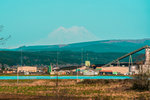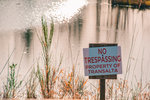

After writing that it was “bad policy” and “unlawful” just weeks prior, Lewis County Commissioner Sean Swope has changed his tune about a proposed wildlife refuge in his district.
Formerly a coal mine, the nearly 10,000 acres owned by power company TransAlta are set to be transferred to the Washington Department of Fish and Wildlife (WDFW). While the agency says it’s a unique opportunity to restore habitat critical to threatened species, county and city officials have staunchly argued that preventing development on the land would represent a huge financial blow.
But now, Swope says perhaps the location isn’t the best spot for development after all. A recent tour of the land with TransAlta’s Cody Duncan helped sway him.
“You know, when you see two elk herds in two different places, it kind of changes your perspective a little bit,” he said this week. “You want to preserve beautiful land. Is that land best served for us to put up big infrastructure? Maybe not.”
It’s a major departure from the opposition local officials voiced earlier. At the request of county commissioners, several local cities sent their own letters of opposition to WDFW. Commissioners considered personally driving from city to city to generate those letters and drum up opposition, and the region’s state Rep. Peter Abbarno, R-Centralia, lambasted the state agency for focusing on species’ recovery “and not recovery for working families.”
Last month, those same tensions were on display during a meeting of local mayors. There, city and county officials condemned WDFW for purportedly neglecting other local property under its care. The condition of those parcels, said Lewis County Assessor Dianne Dorey, is “sad,” and proves that WDFW is unfit to take on even more land. But WDFW Lands Division Manager Cynthia Wilkerson shot back, saying the city of Centralia is responsible for maintenance of those acres.
The interaction left a bad taste in the mouths of some local officials. At that same meeting, Duncan agreed that TransAlta and the county got off on the wrong foot with regard to the proposed wildlife refuge.
“I feel like it kind of came out, unfortunately, on this negative light,” he said. “And we feel like there’s a positive here.”
Swope similarly said the county felt caught off guard by the news that a major tract of land thought to be reserved for development may be transferred to WDFW.
But the first-term commissioner says the relationship between the county, TransAlta and WDFW has since cooled down. Even so, concerns remain about the potential hit to the county’s tax base. And is the land acquisition still “unlawful” in the eyes of the county? Swope says yes, because of how the land is zoned, but “there’s ways that we can work to change that.”
According to Commissioner Gary Stamper, there are no immediate plans to mount any legal challenge.
Linking Habitat
WDFW’s plan to reclaim the old Centralia mine and restore a diverse range of habitats is one of six land acquisition proposals the agency is currently considering. Of those six, the Centralia proposal represents the largest swath of land, and with it, some of the most passionate opposition, according to WDFW officials.
Last week, all six projects garnered the approval of the Washington Fish and Wildlife Commission, a governor-appointed panel that guides WDFW’s policy. The project isn’t a done deal, though, and the land transfer will still likely take years to complete due to TransAlta’s restoration obligations under federal regulations.
On Facebook, TransAlta said it was pleased to hear the news.
For Brian Stewart, of Conservation Northwest, the refuge represents not only an opportunity for recreation closer to urban areas, but a vital link between fragmented habitats across the coast, the Cascades, the Willapa Hills and the Olympics.
“If there’s any hope for connecting these fragmented habitats, these fragmented species, that’s where it’s going to happen,” Stewart said of Lewis County. “It’s a super important linkage in that it’s the only one left. When I say important, I mean there are no other options.”
Stewart heads the organization’s Cascades to Olympics conservation program, which aims to reconnect habitats to restore species’ historic ranges. With climate change forcing species to adapt, and in some cases move, that connectivity is even more important, he said. The kind of fragmentation caused by development — leading to isolated islands of habitat — can quickly magnify the risk of extinction, Stewart said.
In the long run, Stewart thinks the refuge could include infrastructure for wildlife to cross under Interstate 5, facilitating natural species movement while protecting animals and motorists from collisions. With simple infrastructure, underpasses could offer a relatively cheap option. Or, an interstate overcrossing could be constructed, like the I-90 wildlife crossing that spans multiple lanes of traffic at Snoqualmie Pass. The latter would be a much bigger and more expensive endeavor.
It’s an exciting idea for conservationists as well as recreation organizations. Backcountry Hunters & Anglers have thrown their support behind the proposal, and the South Sound chapter of the Puget Sound Anglers called the proposal “a rare opportunity.”
If the refuge lives up to the excitement, Swope said he could see it being a boon for local tourism.